Elevating Spaces with Large Stairwell Art
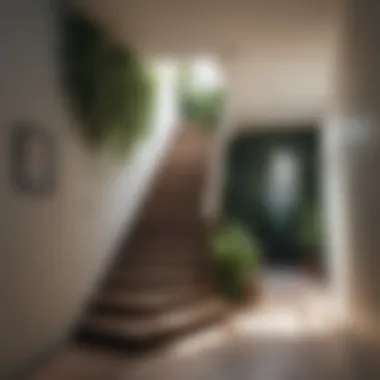
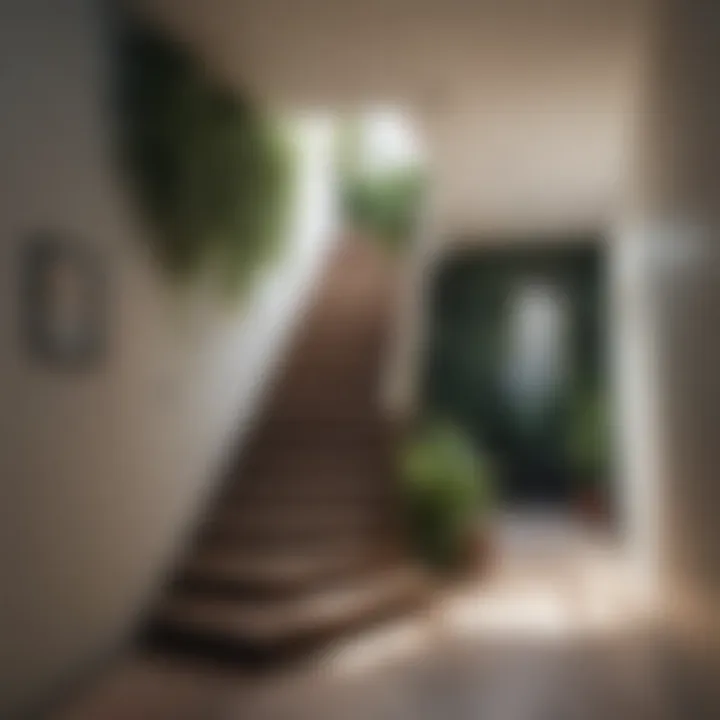
Intro
Stairwells are more than just functional spaces; they are the bridges connecting different levels of a building. For many homeowners and design enthusiasts, these often-overlooked areas present a unique canvas. Enter large stairwell art. The impact of scale, placement, and thematics in stairwell art is substantial, affecting both atmosphere and flow in a space. By incorporating artwork in these areas, you can not only bolster aesthetic appeal but also evoke emotion and reflection as one ascends or descends.
In this article, we will explore this transformative aspect of interior design, emphasizing how choosing the right pieces and positioning them thoughtfully can enhance your environment. We’ll break down key elements such as design inspirations, maintenance considerations, and practical tips.
Design Inspirations
Large stairwell art opens up endless creative avenues for homeowners. The right artwork can define space and set a tone that resonates throughout the home, and perhaps even beyond. Whether it's an eye-catching mural or a series of framed prints, art has the power to make a striking statement.
Trending Styles
Currently, there is a movement towards mixed media. Art that incorporates not just painting, but also materials like metal and wood creates an intriguing visual experience. The following are some popular styles:
- Geometric Abstracts: Clean lines and shapes that add a contemporary vibe.
- Nature Themes: Large-scale landscapes or botanical prints that bring a touch of the outdoors inside.
- Inspirational Quotes: Bold typography that can serve as both decor and motivation.
Color Palettes
The choice of color can transform the ambiance of a stairwell dramatically. For instance, warm tones like oranges and reds can evoke energy, while cool tones such as blues and greens promote calmness. Here's how you might consider colors:
- Monochromatic Schemes: Keeping a singular color in various shades for a cohesive look.
- Complementary Colors: Utilizing colors opposite on the color wheel to create intrigue and depth.
- Neutral Background with Pops of Color: This allows the artwork to stand out while maintaining a sophisticated backdrop.
Maintenance and Upkeep
Once you’ve selected the perfect pieces for your stairwell, it’s equally important to maintain their visual appeal through a regular maintenance schedule. Art not only serves to inspire but can also accumulate dust and wear over time.
Seasonal Maintenance Checklist
To ensure your stairwell art remains as vibrant as day one, consider this checklist:
- Spring Cleaning: Use a soft cloth to wipe off dust from frames and surfaces.
- Check for Fading: Assess artwork for any discoloration, particularly in sunny areas.
- Rearrange Periodically: Every few months, consider reshuffling the artwork’s arrangement to bring fresh energy to the space.
Cleaning and Organization Tips
Effectively cleaning and organizing the space can help maintain its aesthetic integrity. Here are some practical tips:
- Use appropriate cleaning products depending on the art medium (e.g., different methods for canvases versus glass).
- Store any off-season decor carefully to reduce clutter and allow the artwork to shine.
- Consider labeling storage items to find what you need quickly.
"Art enables us to find ourselves and lose ourselves at the same time." - Thomas Merton
The integration of large stairwell art isn't merely about beautifying a space; it anchors it, providing context and character. Take the time to explore the profound impact it can have. Each piece tells a story and connects different elements of your design journey.
Preamble to Stairwell Art
Stairwells, often thought of as mere passages connecting different floors, can serve as vital arenas for artistic expression. The concept of stairwell art transcends mere decoration; it intertwines functionality with creativity, allowing homeowners and designers to turn functional spaces into visual narratives. This section explores how integrating art into stairwells not only enhances the aesthetic value but also transforms the atmosphere of a space, making it engaging and memorable.
The Role of Art in Interior Design
Art has long held a significant role in interior design, acting as both a focal point and a subtle enhancer of the surrounding environment. When we think about the relationship between art and design, it’s crucial to understand that art serves as a bridge connecting various experiences within a space:
- Aesthetic Appeal: Visually striking pieces draw attention, providing enjoyment and inspiring thoughts.
- Personal Identity: Art often reflects the homeowner’s personality or values, making the space uniquely theirs.
- Spatial Dynamics: Strategically placed artworks can alter perceptions of space, making it feel larger or more intimate. Through thoughtful placement in stairwells, art can play a pivotal role in how one perceives the transition between spaces.
Why Choose Large Artwork for Stairwells?
Opting for large artwork in stairwells is not just about making a statement; it carries practicality alongside artistic expression. Consider the following benefits:
- Scale Matters: Large artworks naturally draw the eye, commanding attention and creating an impactful first impression. They're especially useful in grand or spacious stairwells, where small pieces might get lost.
- Visual Connection: By incorporating large pieces, a visual continuity is established that can unify different areas of a home. This is essential for transitions that occur in stairwells, which connect diverse areas such as living rooms, kitchens, or bedrooms.
- Emotional Resonance: Big artworks often elicit stronger feelings. A sweeping mural or an expansive canvas can evoke emotions, making the mundane act of climbing or descending stairs feel more engaging.
- Conversation Starters: Unique, large art pieces can become focal points for conversations. They break the ice and can lead to discussions about the art itself, the artist, or the themes it represents.
Understanding the Stairwell Space
The stairwell is often an overlooked area in home design, a transition space that sees everyday foot traffic yet seldom receives the attention it deserves. Understanding the stairwell space is pivotal in harnessing the aesthetic potential of large stairwell art. A thoughtfully designed stairwell not only serves a functional purpose but also acts as a canvas to express personal taste and creativity.
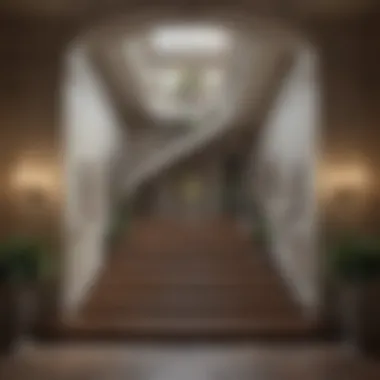
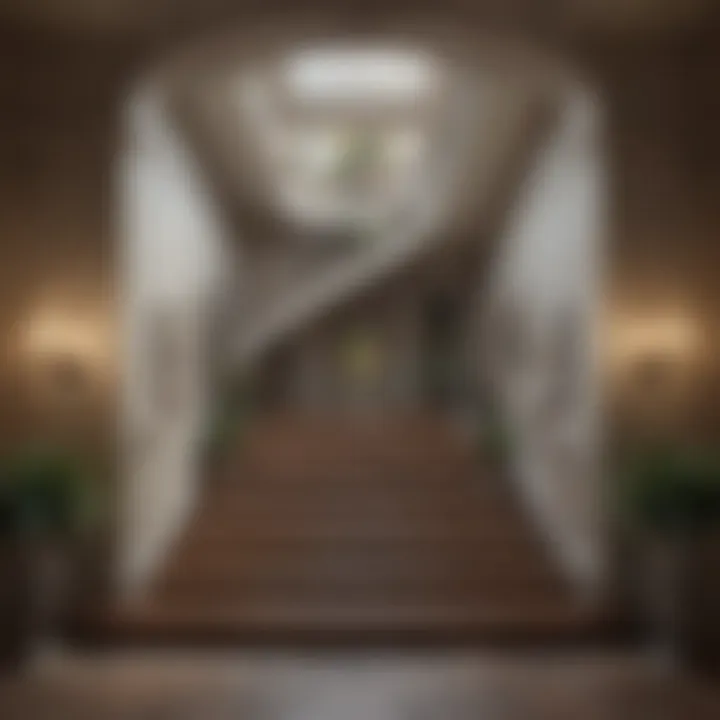
In this part of the article, we'll delve into several key elements that affect how art can enhance the stairwell environment. This includes considering dimensions and architectural features of the stairwell, evaluating lighting conditions, and acknowledging the natural flow and movement in these spaces. Each of these factors plays a crucial role in determining the type and placement of art that will achieve the desired impact.
Dimensions and Architectural Features
The dimensions and architectural features of a stairwell fundamentally dictate what kind of art will fit and flourish. The height, width, and shape of the stairwell determine how large or small the artwork can be, and how it interacts with the surrounding space. For instance, a narrow stairwell may benefit from vertical artwork that draws the eye upwards, creating an illusion of height. In contrast, a wide stairwell could accommodate larger, sprawling murals that create a sense of immersion.
Additionally, the style of the stairwell - be it modern, traditional, or industrial - influences the choice of art. The materials used, including concrete, wood, or glass, may provide an aesthetic backdrop that complements or contrasts with the artwork chosen. Think of a sleek metal railing that could enhance the vibrancy of a colorful abstract painting.
Lighting Considerations
Lighting is another cornerstone of stairwell design that shouldn't be brushed aside. It can dramatically affect the perception and mood of any artwork displayed. Natural light plays a significant role, while artificial lighting can manipulate the atmosphere further. Bright, well-lit stairwells might allow for vivid colors to shine, while dimly lit areas may lend a cozy feel, favoring more subdued colors or materials.
Consider accent lights or spotlights that direct attention to the artwork. Proper placement can enhance textures and colors, transforming the art into an eye-catching feature rather than just another decoration. Moreover, as the lighting changes throughout the day, the art might take on new dimensions and character, further enriching the viewer's experience.
Flow and Movement in Stairwells
Understanding how people navigate stairwells is essential when integrating large artwork. This necessitates thinking about the flow and movement in stairwells. The point of entry, the rhythm of foot traffic, and the vantage points from which art can be viewed all play a part in selecting and showcasing stairwell art.
Art should not obstruct the flow but rather guide the eye and enhance the experience of moving between levels. A mural that wraps around a landing can invite a pause, adding a moment of contemplation during a routine ascent or descent. Likewise, using staggered arrangements or varied heights can create visual interest without disrupting movement.
"Art is not what you see, but what you make others see." - Edgar Degas
In summary, a profound understanding of the stairwell space lays the foundation for integrating large-scale art effectively. When dimensions, lighting considerations, and the natural flow of movement are thoughtfully considered, art becomes more than just decoration; it transforms the stairwell into an engaging and harmonious transition space.
Types of Large Stairwell Art
Art can absolutely make or break a space, and stairwells are no exception. When looking at large-scale art for stairwells, one discovers an exquisite opportunity to transform blank walls into captivating conversations. But what goes into choosing the right type of large stairwell art? This section dives into three popular categories: murals, sculptures, and installations. By exploring these options, homeowners and design enthusiasts can better understand how each kind offers not just aesthetic value but also emotional resonance.
Murals: Transformative Wall Art
Murals have stood the test of time as a powerful way to convey stories and emotions. Their sheer size allows for dramatic expressions that can infuse a stairwell with life and narrative. One significant benefit of murals is their ability to capture a space's essence, harmonizing well with its architectural features.
Consider a mural that reflects the local landscape, wrapping around the stairwell in a 360-degree view. This form of art can draw the eye upward in a manner that feels almost immersive, creating a dynamic experience. Moreover, murals can be painted directly onto walls, reducing the need for additional framing or supports. Think of those vibrant city scenes or nature-inspired designs; they work splendidly in spaces where guests might feel a bit confined.
However, choosing the right artist is essential. An experienced muralist will understand how to navigate scale, color schemes, and themes that connect with the space’s flow.
Sculpture: Adding Dimension to Stairwells
Sculptures may seem a tad unconventional for stairwells, but incorporating three-dimensional art can truly elevate the aesthetic experience. Sculptures add physical texture and dimension, making the verticality of a stairwell more engaging. When creating a focal point, a striking sculpture can serve as a captivating centerpiece.
Think about how the materials used can impact aesthetics. A sleek metal piece can lend a modern flair, while a rustic wooden sculpture can evoke warmth and an organic touch. Additionally, the placement of a sculpture can enhance how the stairwell interacts with surrounding spaces. A strategically placed sculpture at the landing, for instance, can engage viewers as they ascend and descend.
Here’s where practicality meets art. Sculptures can often be situated without needing intricate mounting systems, making them versatile options in terms of placement.
Installations: Engaging the Viewer
Installations take artistry to another level by creating experiences rather than merely displaying objects. These can involve mixed media, sound, and lighting elements that not just populate but transform the stairwell environment into a sensory space. Installations compel viewers to engage in a dialogue with the artwork as they move through the stairwell.
For example, an installation that incorporates mirrors and lighting can magnify natural light, enhancing the ambiance. You could even contemplate a hanging installation that interacts with the airflow within the stairwell, subtly altering perspectives based on visitors' movement.
However, incorporating installations requires a bit more planning. The artist must take into account the stairwell's dimensions and how visitors will interact with the piece over time. But the result? A wholly immersive experience that captivates anyone who steps foot in that space.
"Art isn’t just something you see; it’s an experience you feel. A well-placed mural, sculpture, or installation will change how you view stairwell spaces forever."
Choosing the Right Art for Your Stairwell
Selecting artwork for your stairwell goes beyond mere decoration; it delves into how art shapes our experience of space. Large stairwell art presents an opportunity to make a statement, to echo personal identity or architectural style. The right choice not only complements your home’s atmosphere but also invites engagement from those who traverse the space.
Personal Style and Artistic Intent
When it comes to choosing art that resonates, personal style plays a pivotal role. Think about what you love. Are you drawn to the bold strokes of abstract art or the delicate detail of realism?

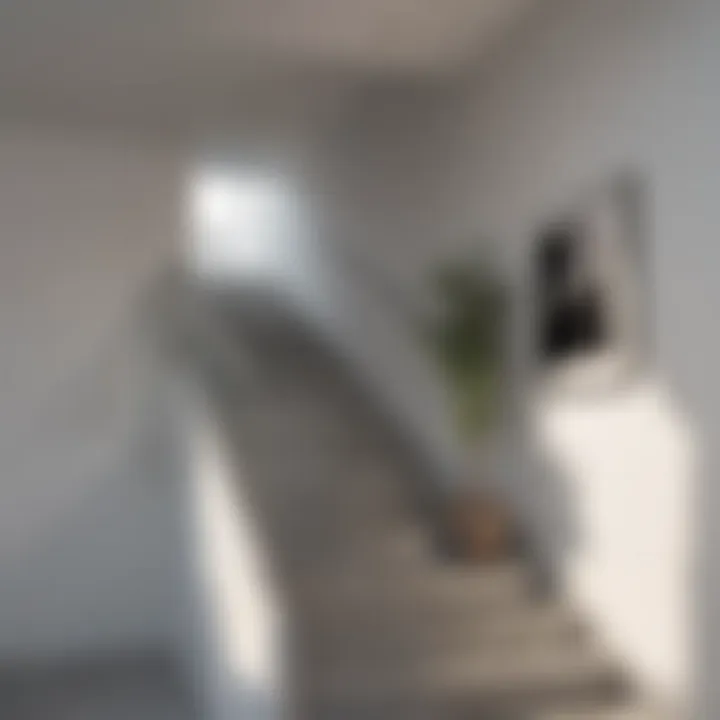
- Reflect on your history with art and how it influences your decor.
- Consider the emotions different styles evoke.
- Is your home a cozy retreat, or might it have an edgy, urban vibe?
Your choices should align with artistic intent. If you wish to inspire contemplation, perhaps a serene landscape would serve well. For a burst of energy, something vibrant, like a pop-art piece, might do the trick. Authenticity shines through when your selection is personal; it transforms spaces into extensions of self.
Color Schemes and Themes
Matching your artwork to the overall color scheme of the stairwell is a huge consideration. Feel free to let the colors of the art resonate with or contrast the existing hues in the space. Think of it as a dance: harmonious colors can create tranquility, while bold contrasts can draw the eye and create excitement. Here are a few tips:
- Analyze your stairwell's existing palette. Does it feature soft, muted tones? Consider art with warmer, inviting colors.
- If the area is rich in deep shades, pieces with bright pops of color can become striking focal points.
- Don't shy away from thematic unity. If your home carries a nautical vibe, coastal prints can seamlessly tie in.
"It’s not about filling space; it’s about enhancing it through intentional choices."
Materiality and Sustainability
Sustainability continues to grow in importance for many homeowners. Selecting art made from sustainable materials not only reflects care for the environment but can also influence the texture and feel of your stairwell. Here are some points to ponder:
- Material durability: High foot traffic areas like stairwells should ideally feature art that endures wear and tear. Think metal sculptures or resistant canvas pieces.
- Eco-friendly options: Many artists now use recycled materials. Incorporating these can add a unique narrative to the art while aligning with personal values regarding sustainability.
- Maintenance needs: Consider the upkeep of your chosen material. Lightweight, smooth surfaces are easier to maintain than textured ones that might gather dust.
Selecting the right art for your stairwell isn't merely about choosing something that looks pretty. It’s an opportunity to channel your unique taste, echoing your environment, and considering thoughtful sustainability.
Placement Strategies for Optimal Impact
When integrating large art pieces into stairwells, placement plays a critical role. The right strategies not only accentuate the artwork but can transform the overall ambiance of the space. A well-placed piece can guide the eye, create depth, and even influence foot traffic within the stairwell.
Creating Focal Points
To create a focal point with stairwell art, you want it to stand out but also harmonize with the surrounding environment. The first step is to determine the height at which your art will be viewed. Generally, placing art at eye level is best, as it draws attention without requiring guests to strain their necks. For tall spaces, consider a large piece reaching toward the ceiling. It can evoke a sense of grandeur and make quite an impression.
"Art is not what you see, but what you make others see." – Edgar Degas
When determining focal points, think about how light plays on the artwork. Natural light from windows or ceiling fixtures can enhance certain colors or textures, making the art piece even more striking. Another good approach is to position the art against a plain background to help it pop. For instance, if you have a mural painted in earthy tones, a white or gray wall could convey a clean, crisp aesthetic, amplifying the mural's beauty.
Augmenting Vertical Space
Capitalizing on vertical space is essential in high-ceiling stairwells. Utilizing tall, narrow artwork or a series of vertical installations can create a pleasing flow. This approach not only draws the eye upward but also emphasizes the architectural features of the stairwell.
In addition, one can stagger smaller pieces along the stairwell walls. This not only keeps the viewer's eyes moving but can evoke a sense of discovery as visitors ascend or descend. Here are some tips for clever vertical placements:
- Employ mirrors at strategic spots. They can reflect light and give the illusion of more space, complimenting your artwork.
- Consider the height of the stair railing. Ensure the art isn't obstructed but also doesn’t overwhelm the space.
Staggered Arrangements
Staggered arrangements create a rhythmic pattern along the stairwell and maintain visual interest throughout the ascent or descent. This method can be particularly effective with a series of framed prints or photos.
Use varying sizes and orientations of the pieces to create a dynamic look. For a well-rounded appearance, ensure some pieces are close to the eye, while others sit higher, eliciting intrigue from viewers. Here’s how to create a staggered setup effectively:
- Select a theme or color palette that resonates with the stairwell's ambiance, ensuring cohesion.
- Use different frame styles for added visual texture and appeal, taking care that they share some common design element.
- Plan a pathway through the art pieces. When viewed together, they should guide one’s gaze, ensuring a seamless experience as one moves through the space.
By thoughtfully applying these placement strategies, stairwell art can transform an often-overlooked space into a captivating visual narrative. Remember, the key lies in creating connections between the art, the architectural design, and the experience of the onlooker.
Maintenance of Stairwell Art
Keeping large stairwell art in top-notch condition is essential for both aesthetic appeal and longevity. Stairwells, often ignored in terms of decor, can truly shine with the right artwork. However, it’s a unique environment; humidity, light exposure, and foot traffic can all take their toll on these pieces. Understanding the upkeep necessary not only enhances the visual impact but also preserves the integrity of the artwork for years to come.
Cleaning Techniques for Different Materials
When it comes to cleaning, different materials used in stairwell art require tailored techniques. Here are some general guidelines:
- Canvas and Fabric: For artworks made from canvas or textile, gentle dusting with a soft cloth can do wonders. If stains appear, a damp cloth with mild soap usually works best. Avoid soaking the material; a light touch is key.
- Wood: Wooden art pieces require a little more care. Use a varnish cleaner or a cloth slightly dampened with water. Too much moisture can warp wood, so keep it minimal.
- Metal: For sculptures or hanging metal art, a microfiber cloth is your best bet. It avoids scratches and effectively removes fingerprints and dust. In some cases, a further polish with a suitable metal cleaner can restore shine.
- Glass: Glass pieces can get smudged or dusty quickly, especially in busy areas. A glass cleaner with a soft microfiber cloth will help maintain that sparkling finish. Regular cleaning can prevent buildup that could cloud the glass over time.
Tip: Always test cleaners on a small, inconspicuous area before applying it to the entire piece.
Preserving Visual Integrity
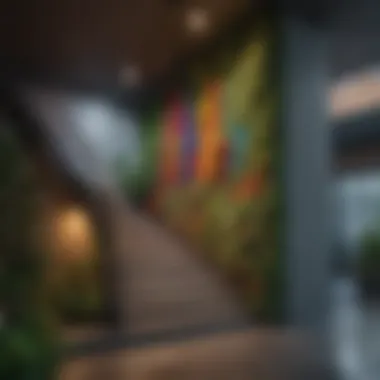
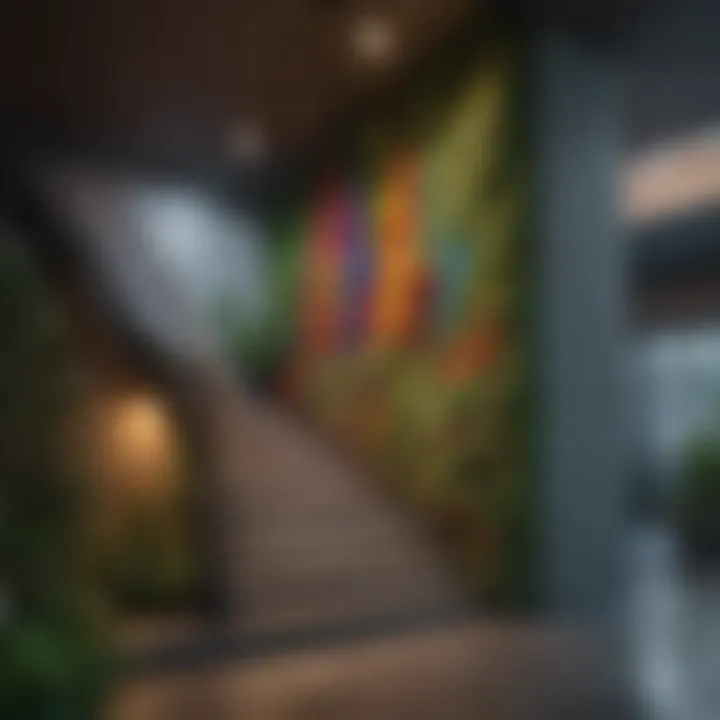
Once cleaned, it’s crucial to think about preserving the visual integrity of the artwork. This includes not just cleaning techniques but ensuring the piece remains vibrant and true to its original form.
- Avoid Direct Sunlight: For paintings or textiles, direct sunlight can cause fading. Consider using UV-filtering glass or placing the art in a spot where sunlight's harsh rays don’t hit directly.
- Control Humidity: High humidity can lead to mold or warping, especially in wood or canvas artworks. Ensure proper ventilation in the stairwell to minimize these risks.
- Regular Inspections: Every so often, take a moment to inspect the artwork for any signs of wear and tear. A scratch now can become a bigger issue later if not addressed promptly.
- Coatings and Treatments: Some artworks can benefit from a protective coating. For instance, applying fixative to charcoal or pastel works could help preserve them against smudging.
In summary, maintaining stairwell art is not just about keeping it clean; it’s a holistic approach to ensuring that each piece continues to resonate with the artistic intention and charm that led to its selection. Taking these steps will keep stairwell art looking its best and extend its life in any environment.
Cultural and Historical Context
Understanding the cultural and historical context of stairwell art adds depth to its aesthetic appeal and significance. Art does more than adorn a space; it often encapsulates the identity of the era or society it represents. Many stairwells, which can be seen as transitional spaces, have hosted various artistic expressions throughout history, giving them a unique narrative.
Art through the Ages in Stairwells
Historically, stairwells were often neglected spaces, but over time, this perception shifted dramatically. In ancient Rome, grand staircases in public buildings showcased intricate frescoes and mosaics, creating stunning backdrops that celebrated mythology and history. Fast forward to the Renaissance, and stairwells became canvases for storytelling through elaborate ceiling murals, such as those seen in palatial structures.
Today, stairwell art can pull inspiration from these rich traditions. For instance, a modern stairwell can pay homage to the grandiosity of Italian Renaissance art by incorporating large murals that depict scenes inspired by classical themes. This approach not only beautifies the space but also connects the present with the eloquence of the past, inviting onlookers to engage with art that extends beyond mere decoration.
"Art in stairwells not only serves aesthetic purposes, but it also provides a narrative thread that weaves through the fabric of time."
Regional Variations in Stairwell Art
The diversity in stairwell art across different regions is also noteworthy, as it reflects local culture, resources, and societal values. In some South American countries, for example, stairwells might burst with vibrant colors and motifs that echo indigenous patterns and traditions, setting a lively tone for homes or public buildings. This energetic use of color can lift the spirits and invite movement, making the journey up and down the stairs more engaging.
In contrast, Scandinavian design often emphasizes minimalism and functionality. Stairwell art in this region might take the form of sleek, geometric patterns or monochromatic monochromes that echo the clean lines typical of Nordic architecture. Here, the art complements the architecture, fostering a serene atmosphere that mirrors the natural landscapes chosen by such designs.
When selecting stairwell art, it is beneficial to consider these regional influences and historical legacies. Whether one opts for a contemporary piece that resonates with local artists or an ornate mural evoking historical grandeur, the choice reflects not just personal taste but also a connection to cultural roots.
The Psychological Impact of Art in Transition Spaces
Art adds layers to our experiences, especially in areas often deemed transitional, like stairwells. These spaces, meant primarily for movement, provide a unique opportunity to influence emotional responses and enhance the overall atmosphere of a building or home. When we consider the psychological impact of art, it becomes clear that strategic artistic choices can transform a mundane stairwell into an engaging visual narrative, offering more than just a way to navigate between levels.
Creating a Sense of Welcome
Stairwells are typically overlooked; they function as mere conduits from one floor to another. However, they can also shape the way we feel about a space. Large artwork can evoke warmth or coolness, depending on the colors and themes chosen. A vibrant mural depicting a serene landscape, for instance, might make a person feel as if they are stepping into fresh air, even if just for a moment.
Consider how a stunning piece of art can greet guests as they ascend or descend the stairs. It is almost like putting out the welcome mat.
- Friendly Colors: Warm hues, such as yellows and reds, create a cozy feel.
- Open Themes: Images that evoke nature or community can foster a sense of belonging.
- Cultural References: Art that incorporates local history or symbols can resonate more deeply with those familiar with the surroundings.
"The right piece of art doesn't just fill space; it breathes life into it, creating a sense of arrival or departure that can uplift spirits."
Influencing Mood and Perception
Beyond mere welcome, art in stairwells can significantly influence mood. Transitions are fascinating points in our daily lives, often marked with various emotions. A well-placed installation can shift perceptions and attitudes.
Having art present during these passage moments can lead to better emotional regulation. Different artworks resonate with different individuals. For example:
- Abstract Images: Decide to add an abstract painting that challenges perceptions, encouraging contemplation.
- Inspirational Quotes: Using text art can inspire and motivate, reminding individuals of their aspirations as they move through the space.
- Local Artists: Collaborating with local talent not only enhances community ties but also gives a personalized touch that attendees can relate with.
Epilogue
As we wrap up our exploration of large stairwell art, it's evident that this particular aesthetic choice offers more than just visual appeal. It serves as a bridge between artistic expression and the practicalities of interior design. In a world where first impressions hold significant weight, stairwell art becomes a silent yet persistent communicator of individuality and taste to anyone entering the space.
The Future of Stairwell Art
Looking ahead, the emergence of technology in art is likely to reshape how we perceive and integrate large stairwell pieces. Digital installations, such as projections or interactive displays, could offer dynamic experiences that adapt to changes in lighting or viewer interaction. With each generation growing increasingly engaged with digital art forms, stairwells might transform into bustling canvases that draw attention and evoke emotions in ways we’ve yet to fully comprehend.
Thus, future stairwell art might not just be visual but experiential. This potential shift beckons homeowners and designers alike to rethink conventional art placements.
Embracing Individuality in Design Choices
In the realm of interior design, the phrase "more is more" doesn't always apply. Instead, the focus should shift to how well the piece resonates with the overall aesthetic of the home. With a plethora of art styles, from bold contemporary pieces to tranquil landscapes, each selection should tell a story—that reflects the personality of the homeowner and the ethos of the dwelling.
Consider a few key aspects when it comes to individualized choices in stairwell art:
- Personal Narratives: Choose artworks that evoke memories or moments rather than simply following trends.
- Cohesion: Ensure that the artwork harmonizes not only with the color scheme but also with the furniture and fixtures within the surrounding areas.
- Scale Consideration: A massive mural can enhance the verticality of a stairwell, while a series of small frames can guide the eye upward, creating a sense of journey and discovery.
Art is much more than mere decoration; it becomes a reflection of who we are and how we perceive the world around us. With every step, visitors and residents alike can encounter not just a transition from one level to another, but a fluid narrative crafted through thoughtful selections of art that speak volumes.







